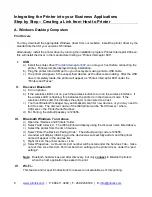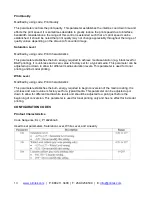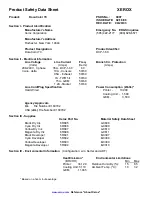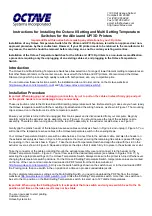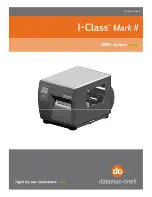
i
www.printek.com
| P: 888.211.3400 | F: 269.925.8539 | E:
FCC Part 15 Class A
This device has been tested and found to comply with Part 15 of the FCC Rules. Operation is subject to the following two
conditions: (1) this device may not cause harmful interference, and (2) this device must accept any interference received,
including interference that may cause undesired operation.
These limits are designed to provide reasonable protection against harmful interference in a residential installation. This
equipment generates, uses, and can radiate radio frequency energy and, if not installed and used in accordance with the
instructions, may cause harmful interference to radio communications. However, there is no guarantee that interference will
not occur in a particular installation. If this equipment does cause harmful interference to radio or television reception, which
can be determined by turning the equipment off and on, the user is encouraged to try to correct the interference by one or
more of the following measures:
Reorient or relocate the receiving antenna.
Increase the separation between the equipment and the receiver.
Connect the equipment into an outlet on a circuit different from that to which the receiver is connected.
Consult the dealer or an experienced radio/TV technician for help.
This equipment emits radio frequency energy but the radiated power is far below the FCC radio frequency exposure limits.
To meet FCC RF exposure rules; do not co-locate or operate this product in conjuncture with another antenna or transmitter
and maintain 20 cm distance from body of user.
Part 15.21 Caution: Changes or modifications not expressly approved by Printek LLC could void the user’s authority to
operate the equipment.
Canadian Department of Communications Radio Interference Statement
This device complies with Industry Canada license-exempt RSS standard(s). Operation is subject to the
following two conditions: 1) this device may not cause interference, 2) this device must accept any interference,
including interference that may cause undesired operation of the device. Under Industry Canada regulations, this
radio transmitter may only operate using an antenna of a type and maximum (or lesser) gain approved for the
transmitter by Industry Canada. To reduce potential radio interference to other users, the antenna type and its
gain should be so chosen that the equivalent isotropically radiated power (e.i.r.p.) is not more than that necessary
for successful communication. Maximum power output plus maximum antenna gain of the EUT is: 4.5W/m
2
,
Limit is 10Wm
2
.
Le présent appareil est conforme aux CNR d'Industrie Canada applicables aux appareils radio exempts de
licence. L'exploitation est autorisée aux deux conditions suivantes : (1) l'appareil ne doit pas produire de
brouillage, et (2) l'utilisateur de l'appareil doit accepter tout brouillage radioélectrique subi, même si le brouillage
est susceptible d'en compromettre le fonctionnement. Conformément à la réglementation d'Industrie Canada, le
présent émetteur radio peut fonctionner avec une antenne d'un type et d'un gain maximal (ou inférieur) approuvé
pour l'émetteur par Industrie Canada.
Dans le but de réduire les risques de brouillage radioélectrique à l'intention des autres utilisateurs, il faut choisir
le type d'antenne et son gain de sorte que la puissance isotrope rayonnée équivalente (p.i.r.e.) ne dépasse pas
l'intensité nécessaire à l'établissement d'une communication satisfaisante.
La puissance de sortie maximale plus
gain d'antenne maximal du EUT est :
4.5W/m
2
Limite est
10W/m
2
Additional Regulatory Marks
ISO 7637-2-2004 Road Vehicle Transients Conducted on Power Lines
PITO AES 5 Issue 10
CE and e-mark
FCC Part 15, Class A
Battery Disposal
Only dispose of used batteries according to your local regulations. If you do not know your local
regulations, the Rechargeable Battery Recycling Corporation (RBRC) is a non-profit organization
created to promote recycling of rechargeable batteries. For more information visit www.rbrc.org.













